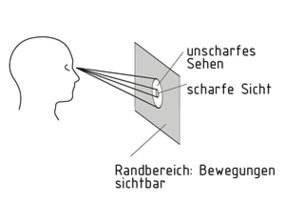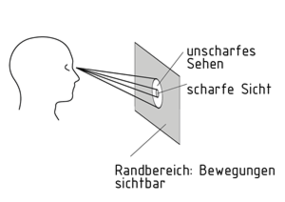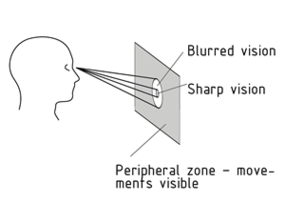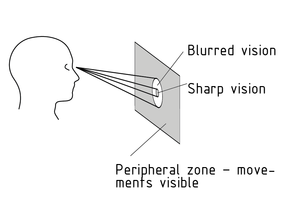
一种定义
四种语言
0,1,2
- 德國
- 英語
- 中國
- 西班牙語
视野

视野是指直视前方且无需移动头部或眼睛时,可以看到的所有区域点。可分为左眼或右眼的单眼视野和左右眼的双眼视野。
一个成年人的双眼视野大约水平延伸 180°,垂直向上 60°,垂直向下 70°。最佳视野以水平或垂直主视线轴左右、上下各延伸 15°。最频繁观察的物体应该位于这个区域。
约 1 - 2°内的视野图像是清晰聚焦的。大约 40°的中间范围只能感知到对比强烈的物体,视野的边缘仅能观察到移动的对象。
人的可视距离究竟差别有多大取决于个人。特别是 55 岁的人,眼球向上运动的能力减少。
在人体工程学工作台上,要被同时观察的物件应放置在视野区域内。
视野和视界并不完全相同。
视野
Gesichtsfeld

Zum Gesichtsfeld gehören alle Punkte, die bei gerade und bewegungslos gehaltenen Kopf und Augen wahrzunehmen sind. Unterschieden werden die monokularen Gesichtsfelder des linken und rechten Auges und das binokulare Gesichtsfeld beider Augen.
Ein Erwachsener hat binokular horizontal ein maximales Gesichtsfeld von rund 180°, vertikal von ca. 60° nach oben und 70° nach unten. Das optimale Gesichtsfeld liegt horizontal wie auch vertikal jeweils 15° auf beiden Seiten der Hauptsehachse. Hier sollten sich die am häufigsten betrachteten Gegenstände befinden.
Der Winkel, in dem scharf gesehen wird, umfasst ca. 1 - 2°. Im Mittelfeld bis etwa 40° werden nur starke Kontraste, am Rand des Gesichtsfeldes nur bewegte Objekte wahrgenommen.
Die maximale Ausdehnung des Gesichtsfeldes ist individuell verschieden. Ab einem Lebensalter von 55 Jahren verringert sich vor allem die mögliche Aufwärtsbewegung der Augen.
Am ergonomischen Arbeitsplatz sollten die gleichzeitig zu überwachenden Objekte im Gesichtsfeld angeordnet sein.
Das Gesichtsfeld wird vom Blickfeld unterschieden.
Visual field

The visual field includes all points that can be seen when looking straight ahead, without moving the head or eyes. A distinction is made between the monocular visual fields of the left and right eyes and the binocular visual field of both eyes.
An adult's binocular visual field extends approximately 180° horizontally, around 60° vertically up, and 70° vertically down. The optimum visual field extends 15° horizontally and vertically to either side of the main axis of view. Objects that are viewed most frequently should be located in this area.
The angle within which vision is sharp and focused is around 1 - 2°. Only strong contrasts can be perceived in the mid-range up to around 40° and only moving objects are seen at the edge of the visual field.
Exactly how far the visual range extends varies from person to person. From the age of 55, the eyes' capacity for upward motion, in particular, decreases.
At ergonomic workstations, items that are to be monitored simultaneously should be positioned within the visual field.
A distinction is made between the visual field and the Field of vision.
Campo visual

El campo visual incluye todos los puntos que pueden ser vistos cuando se ve hacia el frente, sin mover la cabeza o los ojos. Se debe distinguir entre los campos visuales monoculares de los ojos derecho e izquierdo y el campo visual binocular de ambos ojos.
El campo visual binocular de un adulto se extiende aproximadamente 180° horizontalmente, alrededor de 60° verticalmente hacia arriba y 70° verticalmente hacia abajo. El campo visual óptimo se extiende 15° horizontal y verticalmente hacia ambos lados del eje principal de visión. Los objetos que son vistos con mayor frecuencia deben colocarse en esta área.
El ángulo dentro del cual la visión es aguda y enfocada es de alrededor de 1 a 2°. Solo los contrastes fuertes pueden ser percibidos en el rango medio hasta unos 40° y solo los objetos en movimiento son vistos en el borde del campo visual.
La distancia exacta en que se extiende el rango visual varía de persona a persona. A partir de los 55 años la capacidad de los ojos para un movimiento, en particular hacia arriba, disminuye.
En las estaciones de trabajo , los artículos que deben ser monitoreados simultáneamente deben colocarse dentro del campo visual.
Se debe distinguir entre el campo visual y el .
Campo visual
